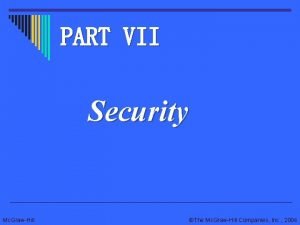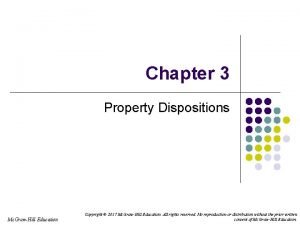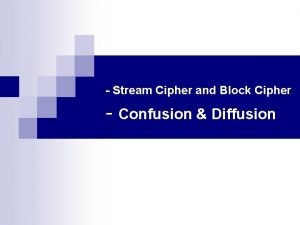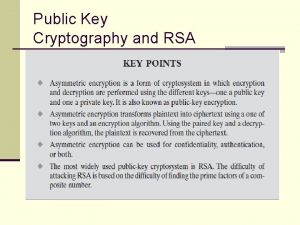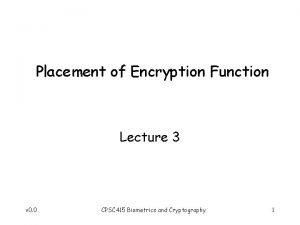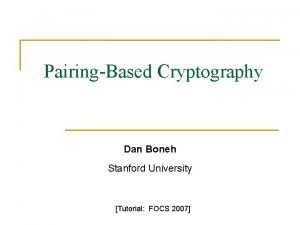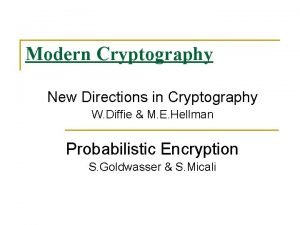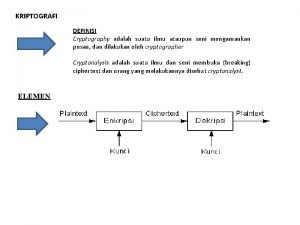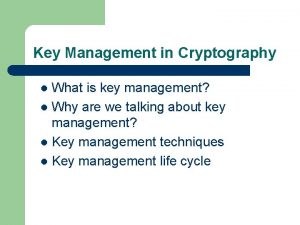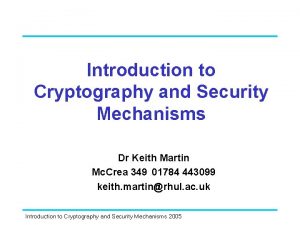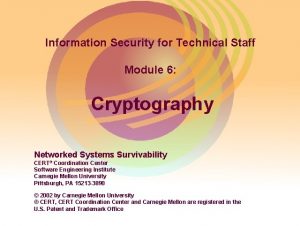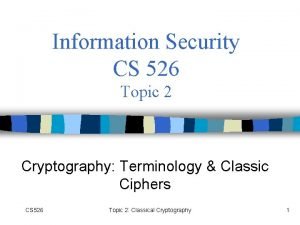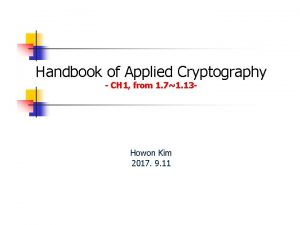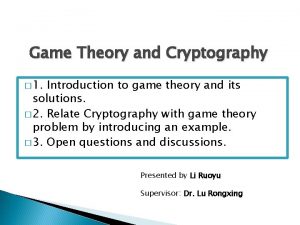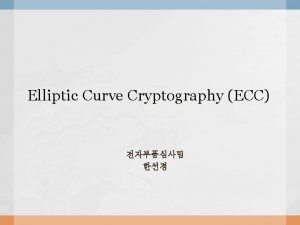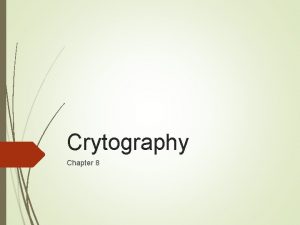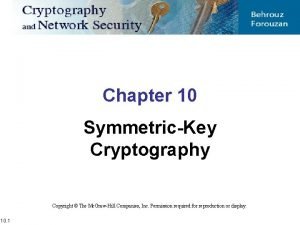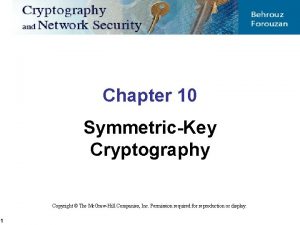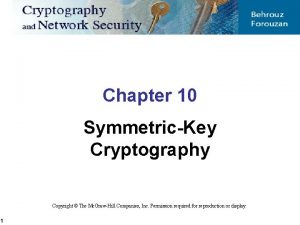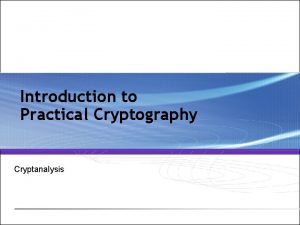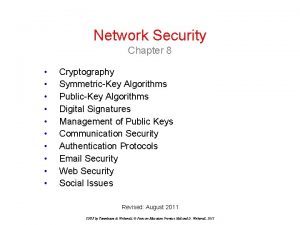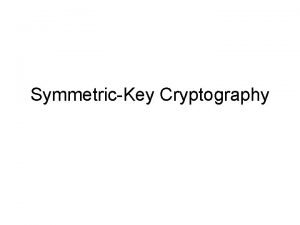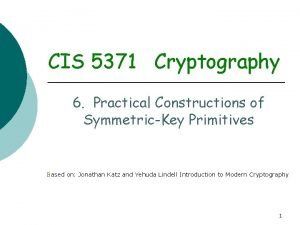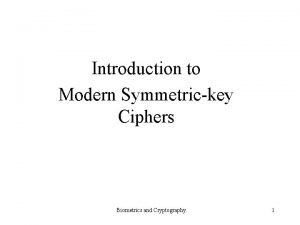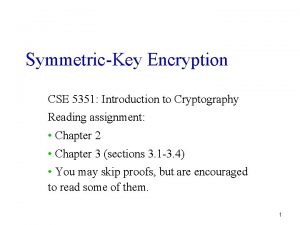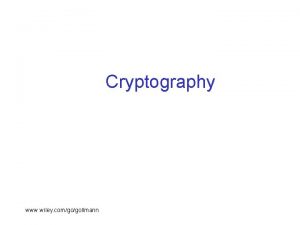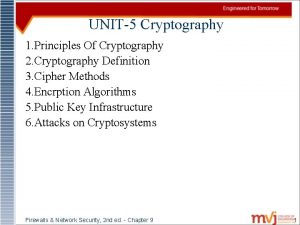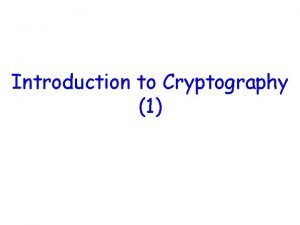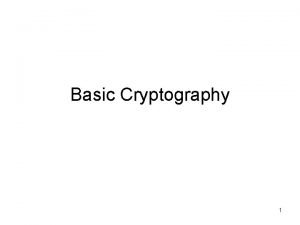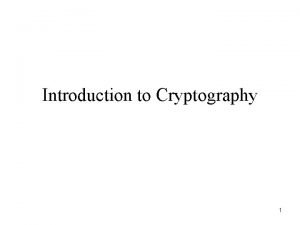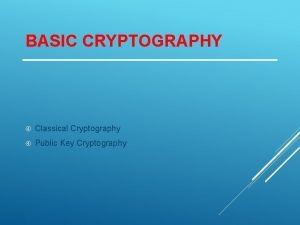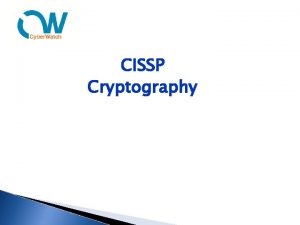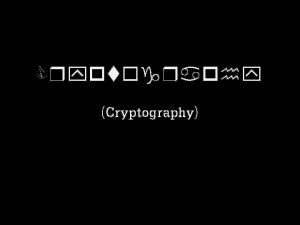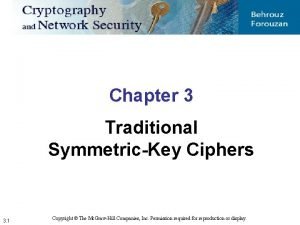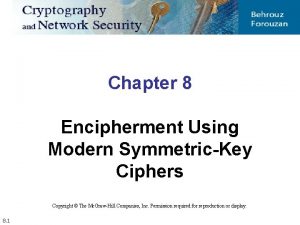Chapter 10 SymmetricKey Cryptography Copyright The Mc GrawHill





































































- Slides: 69

Chapter 10 Symmetric-Key Cryptography Copyright © The Mc. Graw-Hill Companies, Inc. Permission required for reproduction or display. 1

Chapter 10 Objectives q To distinguish between two cryptosystems: symmetric-key and asymmetric-key q To introduce trapdoor one-way functions and their use in asymmetric-key cryptosystems q To introduce the knapsack cryptosystem as one of the first ideas in asymmetric-key cryptography q To discuss the RSA cryptosystem q To discuss the Rabin cryptosystem q To discuss the El. Gamal cryptosystem q To discuss the elliptic curve cryptosystem 2

10 -1 INTRODUCTION Symmetric and asymmetric-key cryptography will exist in parallel and continue to serve the community. We actually believe that they are complements of each other; the advantages of one can compensate for the disadvantages of the other. Topics discussed in this section: 10. 1. 1 10. 1. 2 10. 1. 3 10. 1. 4 10. 1. 5 3 Keys General Idea Need for Both Trapdoor One-Way Function Knapsack Cryptosystem

10 -1 INTRODUCTION Symmetric and asymmetric-key cryptography will exist in parallel and continue to serve the community. We actually believe that they are complements of each other; the advantages of one can compensate for the disadvantages of the other. Note Symmetric-key cryptography is based on sharing secrecy; asymmetric-key cryptography is based on personal secrecy. 4

10. 1. 1 Keys Asymmetric key cryptography uses two separate keys: one private and one public. Figure 10. 1 Locking and unlocking in asymmetric-key cryptosystem 5

10. 1. 2 General Idea Figure 10. 2 General idea of asymmetric-key cryptosystem 6

10. 1. 2 Continued Plaintext/Ciphertext Unlike in symmetric-key cryptography, plaintext and ciphertext are treated as integers in asymmetric-key cryptography. Encryption/Decryption C = f (Kpublic , P) 7 P = g(Kprivate , C)

10. 1. 3 Need for Both There is a very important fact that is sometimes misunderstood: The advent of asymmetric-key cryptography does not eliminate the need for symmetrickey cryptography. 8

10. 1. 4 Trapdoor One-Way Function The main idea behind asymmetric-key cryptography is the concept of the trapdoor one-way function. Functions Figure 10. 3 A function as rule mapping a domain to a range 9

10. 1. 4 Continued One-Way Function (OWF) 1. f is easy to compute. 2. f − 1 is difficult to compute. Trapdoor One-Way Function (TOWF) 3. Given y and a trapdoor, x can be computed easily. 10

10. 1. 4 Continued Example 10. 1 When n is large, n = p × q is a one-way function. Given p and q , it is always easy to calculate n ; given n, it is very difficult to compute p and q. This is the factorization problem. Example 10. 2 When n is large, the function y = xk mod n is a trapdoor oneway function. Given x, k, and n, it is easy to calculate y. Given y, k, and n, it is very difficult to calculate x. This is the discrete logarithm problem. However, if we know the trapdoor, k′ such that k × k ′ = 1 mod f(n), we can use x = yk′ mod n to find x. 11

10. 1. 5 Knapsack Cryptosystem Definition a = [a 1, a 2, …, ak ] and x = [x 1, x 2, …, xk]. Given a and x, it is easy to calculate s. However, given s and a it is difficult to find x. Superincreasing Tuple ai ≥ a 1 + a 2 + … + ai− 1 12

10. 1. 5 Continued 13

10. 1. 5 Continued Example 10. 3 As a very trivial example, assume that a = [17, 25, 46, 94, 201, 400] and s = 272 are given. Table 10. 1 shows how the tuple x is found using inv_knapsack. Sum routine in Algorithm 10. 1. In this case x = [0, 1, 1, 0], which means that 25, 46, and 201 are in the knapsack. 14

10. 1. 5 Continued Secret Communication with Knapsacks. Figure 10. 4 Secret communication with knapsack cryptosystem 15

10. 1. 5 Continued Example 10. 4 This is a trivial (very insecure) example just to show the procedure. 16

10 -2 RSA CRYPTOSYSTEM The most common public-key algorithm is the RSA cryptosystem, named for its inventors (Rivest, Shamir, and Adleman). Topics discussed in this section: 10. 2. 1 10. 2. 2 10. 2. 3 10. 2. 4 10. 2. 5 10. 2. 6 10. 2. 7 17 Introduction Procedure Some Trivial Examples Attacks on RSA Recommendations Optimal Asymmetric Encryption Padding (OAEP) Applications

10. 2. 1 Introduction Figure 10. 5 Complexity of operations in RSA 18

10. 2. 2 Procedure Figure 10. 6 Encryption, decryption, and key generation in RSA 19

10. 2. 2 Continued Two Algebraic Structures Encryption/Decryption Ring: Key-Generation Group: 20 R = <Zn , +, × > G = <Z f(n)∗, × >

10. 2. 2 Continued 21

10. 2. 2 Continued Encryption 22

10. 2. 2 Continued Decryption 23

10. 2. 2 Continued Proof of RSA 24

10. 2. 3 Some Trivial Examples Example 10. 5 Bob chooses 7 and 11 as p and q and calculates n = 77. The value of f(n) = (7 − 1)(11 − 1) or 60. Now he chooses two exponents, e and d, from Z 60∗. If he chooses e to be 13, then d is 37. Note that e × d mod 60 = 1 (they are inverses of each Now imagine that Alice wants to send the plaintext 5 to Bob. She uses the public exponent 13 to encrypt 5. Bob receives the ciphertext 26 and uses the private key 37 to decipher the ciphertext: 25

10. 2. 3 Some Trivial Examples Example 10. 6 Now assume that another person, John, wants to send a message to Bob. John can use the same public key announced by Bob (probably on his website), 13; John’s plaintext is 63. John calculates the following: Bob receives the ciphertext 28 and uses his private key 37 to decipher the ciphertext: 26

10. 2. 3 Some Trivial Examples Example 10. 7 Jennifer creates a pair of keys for herself. She chooses p = 397 and q = 401. She calculates n = 159197. She then calculates f(n) = 158400. She then chooses e = 343 and d = 12007. Show Ted can send a message to Jennifer if he knows e and n. Suppose Ted wants to send the message “NO” to Jennifer. He changes each character to a number (from 00 to 25), with each character coded as two digits. He then concatenates the two coded characters and gets a four-digit number. The plaintext is 1314. Figure 10. 7 shows the process. 27

10. 2. 3 Continued Figure 10. 7 Encryption and decryption in Example 10. 7 28

10. 2. 4 Attacks on RSA Figure 10. 8 Taxonomy of potential attacks on RSA 29

10. 2. 6 OAEP Figure 10. 9 Optimal asymmetric encryption padding (OAEP) 30

10. 2. 6 Continued Example 10. 8 Here is a more realistic example. We choose a 512 -bit p and q, calculate n and f(n), then choose e and test for relative primeness with f(n). We then calculate d. Finally, we show the results of encryption and decryption. The integer p is a 159 -digit number. 31

10. 2. 6 Continued Example 10. 8 Continued The modulus n = p × q. It has 309 digits. f(n) = (p − 1)(q − 1) has 309 digits. 32

10. 2. 6 Continued Example 10. 8 Continued Bob chooses e = 35535 (the ideal is 65537) and tests it to make sure it is relatively prime with f(n). He then finds the inverse of e modulo f(n) and calls it d. 33

10. 2. 6 Continued Example 10. 8 Continued Alice wants to send the message “THIS IS A TEST”, which can be changed to a numeric value using the 00− 26 encoding scheme (26 is the space character). The ciphertext calculated by Alice is C = Pe, which is 34

10. 2. 6 Continued Example 10. 8 Continued Bob can recover the plaintext from the ciphertext using P = Cd, which is The recovered plaintext is “THIS IS A TEST” after decoding. 35

10 -3 RABIN CRYPTOSYSTEM The Rabin cryptosystem can be thought of as an RSA cryptosystem in which the value of e and d are fixed. The encryption is C ≡ P 2 (mod n) and the decryption is P ≡ C 1/2 (mod n). Topics discussed in this section: 10. 3. 1 Procedure 10. 3. 2 Security of the Rabin System 36

10 -3 Continued Figure 10. 10 Rabin cryptosystem 37

10. 3. 1 Procedure Key Generation 38

10. 3. 1 Continued Encryption 39

10. 3. 1 Continued Decryption Note The Rabin cryptosystem is not deterministic: Decryption creates four plaintexts. 40

10. 3. 1 Continued Example 10. 9 Here is a very trivial example to show the idea. 1. Bob selects p = 23 and q = 7. Note that both are congruent to 3 mod 4. 2. Bob calculates n = p × q = 161. 3. Bob announces n publicly; he keeps p and q private. 4. Alice wants to send the plaintext P = 24. Note that 161 and 24 are relatively prime; 24 is in Z 161*. She calculates C = 242 = 93 mod 161, and sends the ciphertext 93 to Bob. 41

10. 3. 1 Continued Example 10. 9 5. Bob receives 93 and calculates four values: a 1 = +(93 (23+1)/4) mod 23 = 1 mod 23 a 2 = −(93 (23+1)/4) mod 23 = 22 mod 23 b 1 = +(93 (7+1)/4) mod 7 = 4 mod 7 b 2 = −(93 (7+1)/4) mod 7 = 3 mod 7 6. Bob takes four possible answers, (a 1, b 1), (a 1, b 2), (a 2, b 1), and (a 2, b 2), and uses the Chinese remainder theorem to find four possible plaintexts: 116, 24, 137, and 45. Note that only the second answer is Alice’s plaintext. 42

10 -4 ELGAMAL CRYPTOSYSTEM Besides RSA and Rabin, another public-key cryptosystem is El. Gamal is based on the discrete logarithm problem discussed in Chapter 9. Topics discussed in this section: 10. 4. 1 10. 4. 2 10. 4. 3 10. 4. 4 10. 4. 5 10. 4. 6 43 El. Gamal Cryptosystem Procedure Proof Analysis Security of El. Gamal Application

10. 4. 2 Procedure Figure 10. 11 Key generation, encryption, and decryption in El. Gamal 44

10. 4. 2 Continued Key Generation 45

10. 4. 2 Continued 46

10. 4. 2 Continued Note The bit-operation complexity of encryption or decryption in El. Gamal cryptosystem is polynomial. 47

10. 4. 3 Continued Example 10. 10 Here is a trivial example. Bob chooses p = 11 and e 1 = 2. and d = 3 e 2 = e 1 d = 8. So the public keys are (2, 8, 11) and the private key is 3. Alice chooses r = 4 and calculates C 1 and C 2 for the plaintext 7. Bob receives the ciphertexts (5 and 6) and calculates the plaintext. 48

10. 4. 3 Continued Example 10. 11 Instead of using P = [C 2 × (C 1 d) − 1] mod p for decryption, we can avoid the calculation of multiplicative inverse and use P = [C 2 × C 1 p− 1−d] mod p (see Fermat’s little theorem in Chapter 9). In Example 10. 10, we can calculate P = [6 × 5 11− 1− 3] mod 11 = 7 mod 11. Note For the El. Gamal cryptosystem, p must be at least 300 digits and r must be new for each encipherment. 49

10. 4. 3 Continued Example 10. 12 Bob uses a random integer of 512 bits. The integer p is a 155 -digit number (the ideal is 300 digits). Bob then chooses e 1, d, and calculates e 2, as shown below: 50

10. 4. 3 Continued Example 10. 10 Alice has the plaintext P = 3200 to send to Bob. She chooses r = 545131, calculates C 1 and C 2, and sends them to Bob calculates the plaintext P = C 2 × ((C 1)d)− 1 mod p = 3200 mod p. 51

10 -5 ELLIPTIC CURVE CRYPTOSYSTEMS Although RSA and El. Gamal are secure asymmetrickey cryptosystems, their security comes with a price, their large keys. Researchers have looked for alternatives that give the same level of security with smaller key sizes. One of these promising alternatives is the elliptic curve cryptosystem (ECC). Topics discussed in this section: 10. 5. 1 10. 5. 2 10. 5. 3 10. 5. 4 52 Elliptic Curves over Real Numbers Elliptic Curves over GF( p) Elliptic Curves over GF(2 n) Elliptic Curve Cryptography Simulating El. Gamal

10. 5. 1 Elliptic Curves over Real Numbers The general equation for an elliptic curve is Elliptic curves over real numbers use a special class of elliptic curves of the form 53

Example 10. 13 Figure 10. 12 shows two elliptic curves with equations y 2 = x 3 − 4 x and y 2 = x 3 − 1. Both are nonsingular. However, the first has three real roots (x = − 2, x = 0, and x = 2), but the second has only one real root (x = 1) and two imaginary ones. Figure 10. 12 Two elliptic curves over a real field 54

10. 5. 1 Continued Figure 10. 13 Three adding cases in an elliptic curve 55

10. 5. 1 Continued 1. 2. 3. The intercepting point is at infinity; a point O as the point at infinity or zero point, which is the additive identity of the group. 56

10. 5. 2 Elliptic Curves over GF( p) Finding an Inverse The inverse of a point (x, y) is (x, −y), where −y is the additive inverse of y. For example, if p = 13, the inverse of (4, 2) is (4, 11). Finding Points on the Curve Algorithm 10. 12 shows the pseudocode for finding the points on the curve Ep(a, b). 57

10. 5. 2 Continued 58

Example 10. 14 The equation is y 2 = x 3 + x + 1 and the calculation is done modulo 13. Figure 10. 14 Points on an elliptic curve over GF(p) 59

10. 5. 2 Continued Example 10. 15 Let us add two points in Example 10. 14, R = P + Q, where P = (4, 2) and Q = (10, 6). a. λ = (6 − 2) × (10 − 4)− 1 mod 13 = 4 × 6− 1 mod 13 = 5 mod 13. b. x = (52 − 4 − 10) mod 13 = 11 mod 13. c. y = [5 (4 − 11) − 2] mod 13 = 2 mod 13. d. R = (11, 2), which is a point on the curve in Example 10. 14. 60

10. 5. 3 Elliptic Curves over GF(2 n) To define an elliptic curve over GF(2 n), one needs to change the cubic equation. The common equation is Finding Inverses If P = (x, y), then −P = (x, x + y). Finding Points on the Curve We can write an algorithm to find the points on the curve using generators for polynomials discussed in Chapter 7. . 61

10. 5. 3 Continued Finding Inverses If P = (x, y), then −P = (x, x + y). Finding Points on the Curve We can write an algorithm to find the points on the curve using generators for polynomials discussed in Chapter 7. This algorithm is left as an exercise. Following is a very trivial example. 62

10. 5. 3 Continued Example 10. 16 We choose GF(23) with elements {0, 1, g, g 2, g 3, g 4, g 5, g 6} using the irreducible polynomial of f(x) = x 3 + x + 1, which means that g 3 + g + 1 = 0 or g 3 = g + 1. Other powers of g can be calculated accordingly. The following shows the values of the g’s. 63

10. 5. 3 Continued Example 10. 16 Continued Using the elliptic curve y 2 + xy = x 3 + g 3 x 2 + 1, with a = g 3 and b = 1, we can find the points on this curve, as shown in Figure 10. 15. . Figure 10. 15 Points on an elliptic curve over GF(2 n) 64

10. 5. 3 Continued Adding Two Points 1. If P = (x 1, y 1), Q = (x 2, y 2), Q ≠ −P, and Q ≠ P, then R = (x 3, y 3) = P + Q can be found as If Q = P, then R = P + P (or R = 2 P) can be found as 65

10. 5. 3 Continued Example 10. 17 Let us find R = P + Q, where P = (0, 1) and Q = (g 2, 1). We have λ = 0 and R = (g 5, g 4). Example 10. 18 Let us find R = 2 P, where P = (g 2, 1). We have λ = g 2 + 1/g 2 = g 2 + g 5 = g + 1 and R = (g 6, g 5). 66

10. 5. 4 ECC Simulating El. Gamal Figure 10. 16 El. Gamal cryptosystem using the elliptic curve 67

10. 5. 4 Continued Generating Public and Private Keys E(a, b) e 1(x 1, y 1) d e 2(x 2, y 2) = d × e 1(x 1, y 1) Encryption Decryption Note The security of ECC depends on the difficulty of solving the elliptic curve logarithm problem. 68

10. 5. 4 Continued Example 10. 19 Here is a very trivial example of encipherment using an elliptic curve over GF(p). 1. Bob selects E 67(2, 3) as the elliptic curve over GF(p). 2. Bob selects e 1 = (2, 22) and d = 4. 3. Bob calculates e 2 = (13, 45), where e 2 = d × e 1. 4. Bob publicly announces the tuple (E, e 1, e 2). 5. Alice wants to send the plaintext P = (24, 26) to Bob. She selects r = 2. 69
 Grawhill
Grawhill Grawhill
Grawhill Grawhill
Grawhill Grawhill
Grawhill Mc graw hill
Mc graw hill Single user multitasking os
Single user multitasking os Grawhill
Grawhill Mc grawhill
Mc grawhill Grawhill
Grawhill Hát kết hợp bộ gõ cơ thể
Hát kết hợp bộ gõ cơ thể Bổ thể
Bổ thể Tỉ lệ cơ thể trẻ em
Tỉ lệ cơ thể trẻ em Gấu đi như thế nào
Gấu đi như thế nào Thang điểm glasgow
Thang điểm glasgow Chúa yêu trần thế
Chúa yêu trần thế Các môn thể thao bắt đầu bằng tiếng đua
Các môn thể thao bắt đầu bằng tiếng đua Thế nào là hệ số cao nhất
Thế nào là hệ số cao nhất Các châu lục và đại dương trên thế giới
Các châu lục và đại dương trên thế giới Công của trọng lực
Công của trọng lực Trời xanh đây là của chúng ta thể thơ
Trời xanh đây là của chúng ta thể thơ Mật thư tọa độ 5x5
Mật thư tọa độ 5x5 Phép trừ bù
Phép trừ bù độ dài liên kết
độ dài liên kết Các châu lục và đại dương trên thế giới
Các châu lục và đại dương trên thế giới Thể thơ truyền thống
Thể thơ truyền thống Quá trình desamine hóa có thể tạo ra
Quá trình desamine hóa có thể tạo ra Một số thể thơ truyền thống
Một số thể thơ truyền thống Cái miệng xinh xinh thế chỉ nói điều hay thôi
Cái miệng xinh xinh thế chỉ nói điều hay thôi Vẽ hình chiếu vuông góc của vật thể sau
Vẽ hình chiếu vuông góc của vật thể sau Biện pháp chống mỏi cơ
Biện pháp chống mỏi cơ đặc điểm cơ thể của người tối cổ
đặc điểm cơ thể của người tối cổ Ví dụ giọng cùng tên
Ví dụ giọng cùng tên Vẽ hình chiếu đứng bằng cạnh của vật thể
Vẽ hình chiếu đứng bằng cạnh của vật thể Fecboak
Fecboak Thẻ vin
Thẻ vin đại từ thay thế
đại từ thay thế điện thế nghỉ
điện thế nghỉ Tư thế ngồi viết
Tư thế ngồi viết Diễn thế sinh thái là
Diễn thế sinh thái là Các loại đột biến cấu trúc nhiễm sắc thể
Các loại đột biến cấu trúc nhiễm sắc thể Bảng số nguyên tố lớn hơn 1000
Bảng số nguyên tố lớn hơn 1000 Tư thế ngồi viết
Tư thế ngồi viết Lời thề hippocrates
Lời thề hippocrates Thiếu nhi thế giới liên hoan
Thiếu nhi thế giới liên hoan ưu thế lai là gì
ưu thế lai là gì Khi nào hổ con có thể sống độc lập
Khi nào hổ con có thể sống độc lập Khi nào hổ con có thể sống độc lập
Khi nào hổ con có thể sống độc lập Sơ đồ cơ thể người
Sơ đồ cơ thể người Từ ngữ thể hiện lòng nhân hậu
Từ ngữ thể hiện lòng nhân hậu Thế nào là mạng điện lắp đặt kiểu nổi
Thế nào là mạng điện lắp đặt kiểu nổi New directions in cryptography
New directions in cryptography Confusion and diffusion example
Confusion and diffusion example Blaise de vigenere cryptography
Blaise de vigenere cryptography Principles of public key cryptography
Principles of public key cryptography Placement of encryption function in cryptography
Placement of encryption function in cryptography Stanford university cryptography
Stanford university cryptography Dan boneh blockchain course
Dan boneh blockchain course Wireless security in cryptography and network security
Wireless security in cryptography and network security New directions in cryptography
New directions in cryptography Pengertian cryptography
Pengertian cryptography What is key management in cryptography
What is key management in cryptography Cryptography
Cryptography Module 06 basic cryptography
Module 06 basic cryptography Cryptography terminology
Cryptography terminology Cryptography
Cryptography Handbook of applied cryptography
Handbook of applied cryptography Cryptography board game
Cryptography board game Elliptic curve cryptography
Elliptic curve cryptography Crytographer
Crytographer




